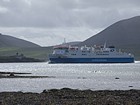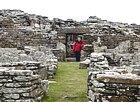
The Orkney Islands with Campervan
Orkney Islands with Campervan June 13-23rd June 2008, words, pictures and links to other sites. Part of our trip to Iceland.

Suzy had never visited the Orkney Islands and though I had been there before, it was only briefly on our way to climb the Old Man of Hoy. Our main objective was Iceland was booked with Smyril Line but as the ferry for Orkney left from the same place, Scrabster it seemed a shame not to experience a few day's island life before our main holiday so we booked on the Northlink ferry as well.
June 13th. The car ferry runs up the west side of Hoy on route to Stromeness and in fine weather it would be possible to get some good views of The Old Man, however, a rocking ferry and poor visibility made this disappointing. On landing at stromeness our first mistake was to take the campervan through the town on route to the campsite, rather than take the ring road and it was fortunate that there was no delivery lorry wanting to pass or I think that we would have been doing some reversing. It's a delightful little town however and much more appealing than the capital, Kirkwall. The campsite was wonderful, sited on a level peninsula with the sea on two sides and views across the Hoy Sound to Hoy.
The Orkney Islands are famous for their prehistoric remains amongst other things and we were looking forward to checking a few of these out during our 10 day stay.Left, the good ship and car ferry MV Hamnavoe as viewed from the campsite.



Needing to stretch our legs, next day we headed for the cliffs of Yesnaby on the west coast of the main island. Overall, Orkney is quite flat except that is for this rugged coastline which also includes some impressive cliffs at Marwick Head, famous for its bird life. However, left picture shows a Yesnaby castle, a fancifully name for a sea stack first climbed in 1967 by Joe Brown and friends. There is also rock climbing to be had on other stretches of these cliffs and a couple of teams could be seen in action. While in the area we also visited Maeshowe, an enigmatic burial chamber which was mysteriously empty when first excavated and entered in 1861 by Archaeologist James Farrer, also the huge Ring of Brodgar stone circle, see centre picture.Right, is the Northern Marsh orchid Dactylorhiza purpurella which was common and by far the most frequent orchid that we saw.



Sunday, we drove to Bay of Skaill where one of Orkney's most famous relic Skara Brae was washed out of the sand dunes after a particularly ferocious storm in 1850. It was very popular and there must have been nearly as many people exploring it as lived there in neolithic times. Similar but actually much later was the 12C Viking settlement at Brock of Gurness, left, Suzy emerging from a part of the ruin.
Famous though it is for its ruins, the Orkney islands are also famous for their bird life and the RSPB reserve at Marwick head is definitely worth a visit. The cliffs are big, somewhere around 80m high and unlike those of Yesnaby they are teeming with bird life. The usual culprits, Fulmars, Guillemots, Black Guillemots, Razor Bills, Skuas both Great and Arctic, and of course Puffins, see middle picture. We spent most of the remaining part of the day pottering along the cliff tops, rain threatening but never arriving. Next day we visited the nature reserve at Mull head, again there was a fair amount of bird life and we learnt about Gloups. What! These are large holes in the ground back from the edge of the sea where a cave has collapsed. Below, Suzy looking towards Chip of the Mull. We rounded the Mull and continued to the Covananters Memorial a sad tale of the Presbyterian sect the Covenanters who were rounded up and in the process of being transported to America as slaves. The ship was wrecked, many drowned in chains and of those that escaped the wreck most were killed by order of the captain.





Thursday 19th June and we are off to Hoy for a couple of days. The car ferry left from the small port of Houton and the weather was wet and windy so we were travelling with a sense of grim optimism. Unlike Orkney, Hoy is quite mountainous with great rounded hills rising to 481 metres at Ward Hill at the north end. Studying the map, I wondered whether anyone ever crossed the bleak and inhospitable range south of the Rackwick road. As we arrived at the slipway at Ly Ness the cloud was almost down to sea level and there was a heavy drizzle. Slightly undeterred we drove off southwards and learnt a lot about 19C Batteries and Martello towers and their history from our effusive guide from Historic Scotland. Afterwards we learnt a lot about the role of Hoy and Scarpa Flow in WW2 from the excellent museum (and cafe) at Ly Ness.
Time to move and we headed back north up the island then over the single track road to Rackwick where we were able to wild camp in the campervan overnight, there are no proper campsites on Hoy, or shops, or petrol stations. Rackwick is the starting point for those wishing to climb the Old Man of Hoy (picture 2) , and there is a camping field and a bunk house. The bay also contains some of the most desirable pebbles in Scotland L-R is the bay seen from the Rackwick Burn which spills out onto the beach and next, just one of whole collection of pictures of pebbles, the best ones being at the far (southern) end.
The weather fined up next morning though it remained very windy so undeterred we headed up for a look at The Old Man as Suzy had only ever seen pictures of it. Picture 3 Suzy and a sign post, 4, the Old Man himself and last, a great Skua or Bonxie as they were known locally. These are ground nesting birds and they let you know in no uncertain terms that you are not welcome, by aggressively diving at ones head. We continued some way along the cliff tops towards St John's Head then turned east following a small burn past the Suifa Lochs and down into the Glens of Broadface. The Bonxies were not happy.



L-R Back on the main island of Orkney the weather turned dull and drizzly again, we visited the remarkable Italian Chapel on Lamb Holm built by Italian prisoners of war that were building the Churchill barriers that link the southern islands in an attempt to prevent U Boats sneaking up on the fleet during WW2. It's stunningly beautiful inside and a remarkable and poignant achievement made by men a long way from home using whatever they could salvage.Middle, Crabs.
The weather deteriorated further and we returned to the campsite at Stromeness where we had to reposition the camper a couple of times as waves shooting were over the defenses onto the campsite.
chris and sue jackson email